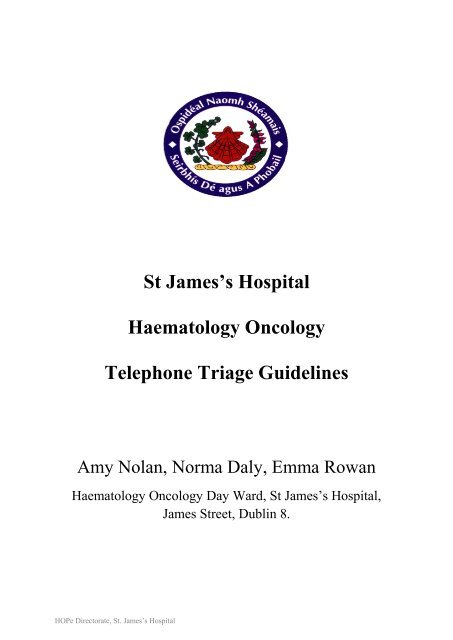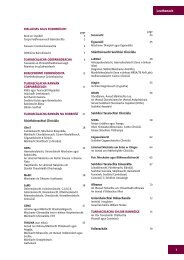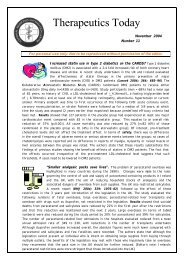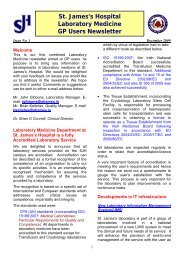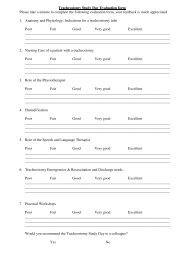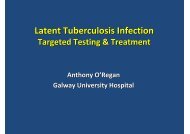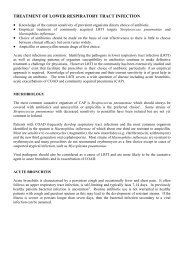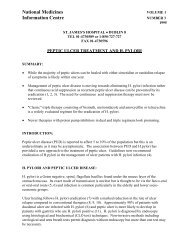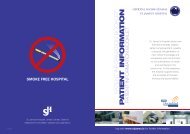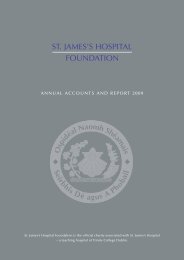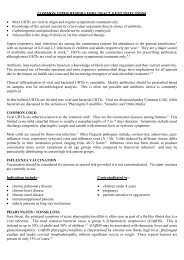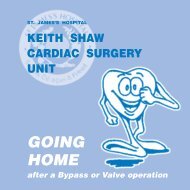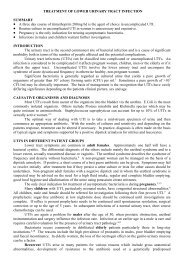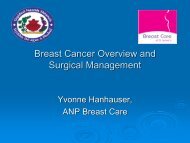Telephone Triage Guidelines - St. James's Hospital
Telephone Triage Guidelines - St. James's Hospital
Telephone Triage Guidelines - St. James's Hospital
You also want an ePaper? Increase the reach of your titles
YUMPU automatically turns print PDFs into web optimized ePapers that Google loves.
HAEMATOLOGY ONCOLOGY TELEPHONE TRIAGE GUIDELINESContentsINTRODUCTION ........................................................................................................................... 3AIMS ........................................................................................................................................... 3SCOPE ......................................................................................................................................... 3INFECTION................................................................................................................................... 4CVAD ........................................................................................................................................ 6NAUSEA ...................................................................................................................................... 7VOMITING ................................................................................................................................... 9DIARRHOEA .............................................................................................................................. 11CONSTIPATION .......................................................................................................................... 16MUCOSITIS ................................................................................................................................ 18BREATHLESSNESS ..................................................................................................................... 20FATIGUE.................................................................................................................................... 23SKIN RASHES ............................................................................................................................ 25ASCITIES ................................................................................................................................... 29MOOD ALTERATION .................................................................................................................. 31PAIN .......................................................................................................................................... 33AMBULATORY PUMP ................................................................................................................. 35PERIPHERAL NEUROPATHY ....................................................................................................... 36REFERENCES ............................................................................................................................. 37APPENDIX 1. ONCOLOGY TELEPHONE TRIAGE FORM ................................................................ 38APPENDIX 2. HAEMATOLOGY TELEPHONE TRIAGE FORM ......................................................... 40HOPe Directorate, <strong>St</strong>. James‟s <strong>Hospital</strong> V2 20122
HAEMATOLOGY ONCOLOGY TELEPHONE TRIAGE GUIDELINESINTRODUCTIONThe Haematology / Oncology services in <strong>St</strong>. James‟s <strong>Hospital</strong> provides over 25,000 episodesof care annually, mostly involving the administration of cytotoxic chemotherapy, which canhave life threatening side effects. <strong>Telephone</strong> triage provides 24 hour assessment and advicefor patients experiencing the effects of disease or treatment. Timely, effective intervention inmanaging these side effects can be life-saving."<strong>Triage</strong>" comes from the French verb "trier" meaning "to separate, sort, sift, select, orchoose".Within the haematology and oncology services, triage refers to the assessment of theexpected and unexpected effects of therapy in order to prioritise and expedite the mostappropriate care for patients.Within the HOPe Directorate, telephone triage is a dedicated service provided by senioroncology and haematology nurses which ensures patient issues are thoroughly assessed anddealt with in an appropriate and timely manner. During core operational hours, the telephonetriage service is provided by the Haematology Oncology Day Ward team and after 6pm, atweekends and on public holidays, by the nursing teams of Denis Burkitt (Haematology) andWalter <strong>St</strong>evenson (Oncology) wards.The following guidelines are used in conjunction with a standardised assessment tool toassess the patients‟ problems. Details of all interactions are recorded on the Electronic PatientRecord (EPR).AIMSThe aims of these guidelines are:• To guide clinical staff in the assessment and management of patients• To guide clinical staff providing advice for patients, carers and/or families.• To standardize the advice given to patients.• To assist the decision making process.• To promote appropriate use of services and resources and support the reduction ofavoidable hospitalizations.• The guidelines should be used in conjunction with the telephone triage form(s)(Appendix 1 & 2).SCOPEThese guidelines apply to all patients experiencing problems following treatment, within theHOPe Directorate.HOPe Directorate, <strong>St</strong>. James‟s <strong>Hospital</strong> V2 20123
HAEMATOLOGY ONCOLOGY TELEPHONE TRIAGE GUIDELINESINFECTIONInitial Assessment Questions1. What is the patient‟s temperature?2. How long has the patient had a temperature?3. Has the patient any shivers or shaking?4. How long have they had shivers or shaking?5. When did the patient receive their last chemotherapy treatment?6. Does the patient have a central venous catheter?7. Does the patient also have any other symptoms?8. Is the patient conscious and responsive9. Is this patient post transplant? If yes follow the algorithm in Figure 1.Figure 1. Algorithm for post transplant patientYes< 100 days posttransplant> 100 days posttransplantAttendHODC/DBWimmediatelyAre they on Imunosuppression: Cellcept Tacrolimus/Cyclosporin Photopheresis <strong>St</strong>eroidsYesNoAttendHODC/DBWDiscuss withDoctor/CNSHOPe Directorate, <strong>St</strong>. James‟s <strong>Hospital</strong> V2 20124
HAEMATOLOGY ONCOLOGY TELEPHONE TRIAGE GUIDELINESINFECTIONACTION: ANY GRADE OF INFECTION (NEUTROPENIA)Patients must be assessed immediately and urgently by clinical staff withexperience of handling neutropenic patients.SIGNS OF INFECTION IN NEUTROPENIC PATIENTSMay include any of the following Pyrexia > 37.5°C on a single reading or < 35°C Rigor or other signs of fever (cold, sweating, shivering) Any signs of infection (sore throat, cough, urinary symptoms, skin lesions) Diarrhoea Any unexplained clinical deterioration, even in the absence of fever. Unexplained abdominal pain Feeling dizzy Other concerns/symptomsFocal signs of infection may or may not be presentIf the patient is apyrexial but symptomatic – has the patient any of the following symptoms: Shortness of breath Cough Rigors Nausea &/or vomiting Diarrhoea Sore throat / ulcers / oral thrush Pain on passing urine Central venous catheter infection Confusion (may be noticed more by carer?)Refer to relevant symptom management section within these guidelines.Note: Patients with CLL not on treatment may be lymphopenic. Please check lastlymphocyte count and discuss with haematology doctor or CNSHOPe Directorate, <strong>St</strong>. James‟s <strong>Hospital</strong> V2 20125
HAEMATOLOGY ONCOLOGY TELEPHONE TRIAGE GUIDELINESCVADInitial Assessment Questions1. What is the device insitu?2. How long since the device was sited?3. Is an Ambulatory pump attached?4. When was the CVAD last accessed?ASKACTIONRednessPainErythemaExudateBleedingTracking? InfectionAttendHODC/WSW/DBW/A&ESurrounding areaswollen/painful?? ThrombosisAttendHODC/WSW/DBW/A&EDamage to hub?Fracture to line?AttendHODC/WSW/DBW/A&ELeak of ambulatorypump?See Ambulatory Care<strong>Guidelines</strong>(Page 35)HOPe Directorate, <strong>St</strong>. James‟s <strong>Hospital</strong> V2 20126
HAEMATOLOGY ONCOLOGY TELEPHONE TRIAGE GUIDELINESNAUSEAInitial Assessment Questions1. Is this a new or recurring problem?2. Onset, frequency, intensity?3. Alleviating/aggravating factors?4. When did the patient receive last chemotherapy treatment or undergo transplant?5. What chemotherapy did they receive?6. Current use of anti emetics?7. Any non-pharmacological interventions?If so what are they?How effective are they?8. How much food and fluid intake over the last 24 hours?9. Any indications of disease recurrence?10. Is the patient taking an opioid or any new medication?Toxicity grading of nausea:NauseaGrade 1 Grade 2 Grade 3 Grade 4Loss of appetitewithout alterationto eating habitsOral intake decreasedwithout significantweight loss, dehydrationor malnutrition; IVfluids indicated for< 24 hoursInadequate caloricintake or fluidintake; IV fluids,tube feeding orTPN indicated for> 24 hoursNCI-CTCAE v3.0 (2003)HOPe Directorate, <strong>St</strong>. James‟s <strong>Hospital</strong> V2 20127
HAEMATOLOGY ONCOLOGY TELEPHONE TRIAGE GUIDELINESNAUSEAASKACTIONGrade 1 & 2: Acute, delayed oranticipatory? Chemotherapy related? No evidence ofdehydration? Is the patient taking anyantiemetic?Offer support, education and follow upas necessary: Review prescribed antiemetictherapy, dose schedule, and routeusing antiemetic protocol. Encourage correct and regularcompliance of prescribed medication. Advise on self help measures i.e. takefrequent small sips of fluids, advise toeat small amounts often, gingerbiscuits or foods containing ginger,take antiemetic 20 minutes prior tomeals. Teach patient to monitor for signs ofdehydration. Distraction therapies to be used inaddition to antiemetic therapy (i.e.music, moderate exercise, relaxation,breathing exercise). Encourage patient to contactdepartment of treatment withinworking hours if symptoms persist orbecome worse.If patient is compliant with antiemeticmedication, contact the medical team toget an alternative antiemetic prescribedand faxed to the pharmacy.Grade 3 Evidence ofdehydration? Unable to eat or drinkfor 24 hours Treatment change noteffective within 6 hours Chemotherapy related? No evidence ofdehydration? Is the patient taking anyantiemetics?Review in HODC/WSW/DBW/A&EimmediatelyHOPe Directorate, <strong>St</strong>. James‟s <strong>Hospital</strong> V2 20128
VomitingHAEMATOLOGY ONCOLOGY TELEPHONE TRIAGE GUIDELINESVOMITINGInitial Assessment Questions1. Is the patient post transplantIf yes discuss with haematology doctor or CNS2. Is this new or a recurring problem?3. Character, colour, force, quantity of vomit?4. Onset, frequency, intensity?5. Alleviating/aggravating factors?6. Current use of anti emetics?7. Any non-pharmacological interventions?If so what are they?How effective are they?8. How much food and fluid intake over the last 24 hours?9. Any abdominal distension?10. Have they also got diarrhoea or constipation?11. Any signs of dehydration, i.e. decreased urine output, fever, thirst, dry mucusmembranes, weakness, dizziness and confusion?12. Other members of the family/household got the same symptoms?13. Are they taking oral chemotherapy?Toxicity grading of vomiting:Grade 1 Grade 2 Grade 3 Grade 4One episode inLife threatening24 hoursconsequences2 – 5 episodes in 24hours; IV fluidsindicated in< 24 hours>6 episodes in 24hours; IV fluids orTPN feeds indicated in> 24 hoursHOPe Directorate, <strong>St</strong>. James‟s <strong>Hospital</strong> V2 20129
HAEMATOLOGY ONCOLOGY TELEPHONE TRIAGE GUIDELINESVOMITINGASKGrade 1 & 2: Acute, delayed oranticipatory? Chemotherapy related? No evidence ofdehydration? Is the patient taking anyantiemetic?Grade 3 Have symptoms lastedfor more than 48 hours? Evidence ofdehydration? Unable to eat or drinkfor 24 hours? Treatment change noteffective within 6 hours?Are they able to eat anddrink?YesACTIONOffer support, education and follow up asnecessary Explore self-care measures. Encourageregular use of prescribed antiemetic. Encourage correct and regular complianceof prescribed medication. Consider review of medication followingantiemetic protocol. Advise on self help measures i.e. takefrequent small sips of fluids, advise to eatsmall amounts often, ginger biscuits orfoods containing ginger, take antiemeticone hour prior to meals. Teach patient to monitor for signs ofdehydration. Distraction therapies to be used in additionto antiemetic therapy (i.e. music,moderated exercise relaxation, breathingexercise). Encourage patient to contact department oftreatment within working hours ifsymptoms persist. Arrange review within 12 hours to includereview of medication using antiemeticprotocol. Contact keyworker/clinical area ifsymptoms persist. Encourage patient to contact department oftreatment within working hours ifsymptoms persist or become worse.Grade 4 Severe vomiting Blood or coffee groundemesis Severe abdominal painor headache Weak, dizzy, incoherentor responsiveNoReview in HODC/WSW/DBW/A&EUrgent review in HODC/WSW/DBW/A&EHOPe Directorate, <strong>St</strong>. James‟s <strong>Hospital</strong> V2 201210
DiarrhoeaHAEMATOLOGY ONCOLOGY TELEPHONE TRIAGE GUIDELINESInitial Assessment QuestionsDIARRHOEA1.What chemotherapy is the patient on?a. If Irinotecan see page 14 for advice b. If Capecitabine see page 15 for advice2. How many stools a day is patient currently experiencing?3. How long has the patient had diarrhoea?4. When was the patient‟s last proper bowel motion?5. Does the patient have any abdominal pain and for how long?6. When did the patient last receive chemotherapy treatment (when if taken oral)?7. Has the patient recently been prescribed antibiotic therapy?8. Has the patient recently been in hospital? (E.g. Contact with C-Diff?)9. Is the patient post bone marrow transplant? If yes see Figure 2 below.Figure 2. Algorithm for Diarrhoea in post transplant patients only How many episodes in24 hours? Is it diarrhoea? Watery Soft What colour is it? Green Brown Have they been startedon antibiotics? Do they have aToxicity temperature? grading of diarrhoea:Grade 1 Grade 2 Grade 3 Grade 4Increase of 4-6 stools Increase >7 stools per dayper day over baseline; over baseline;IV fluids indicated incontinence; IV fluids24 hours;increase in ostomy hospitalization; severeoutput compared to increase in ostomy outputbaseline; not compared to baseline;interfering with ADLIncrease of
HAEMATOLOGY ONCOLOGY TELEPHONE TRIAGE GUIDELINESGrade 1 – 2 DiarrhoeaDIARRHOEAASKACTIONWhat chemotherapyregimen is the patient on?1. If on Irinotecan – see guidelines page 14.2. If on Capecitabine – see guidelines page15.3. If on 5fu infusor consider taking advice fordisconnection of infusor (this must only beperformed by trained professionals/carer).4. If patient is pyrexial see infectionguidelines page 4 & 5.5. Obtain stool specimen.IF NONE OF THE ABOVE......Is the patient takingLoperamide?NoDiscuss with medical doctor. ? obtainprescription for Loperamide and fax topatient‟s pharmacy.YesAfter every episode?YesNoAssess in HODW/WSW/DBW/A&EAdvise patient to take Loperamide after everyepisode of diarrhoea until bowel motions havereturned to baselineREMEMBER TO ALSO ASK.....Are they eating anddrinking? (At least 2-3 litres per day)YesNoNo intervention required at presentAdvise to drink more and arrange reviewwithin 12-24 hoursHOPe Directorate, <strong>St</strong>. James‟s <strong>Hospital</strong> V2 201212
HAEMATOLOGY ONCOLOGY TELEPHONE TRIAGE GUIDELINESDIARRHOEAGrade 3 DiarrhoeaASKACTIONWhat chemotherapyregimen is the patient on?1. If on Irinotecan refer to guideline onpage 14.2. If on Capecitabine refer to guidelineon page 15.3. If on 5fu infusor arrange fordisconnectionAre they eating?Are they drinking morethan 2-3 litres per day?NoAssess patient inHODC/WSW/DBW/A&EPatient must be assessed in an isolationroomAre they takingLoperamide and CodeinePhosphate?Are they drinking morethan 2-3 litres per day?Grade 4 DiarrhoeaYesBring to isolation room inHODC/WSW/DBW/A&E forassessment.Arrange for an immediate assessment in HODC/WSW/DBW/A&EHOPe Directorate, <strong>St</strong>. James‟s <strong>Hospital</strong> V2 201213
HAEMATOLOGY ONCOLOGY TELEPHONE TRIAGE GUIDELINESDIARRHOEATREATMENT OF DIARRHOEA FOR PATIENTS ON IRINOTECAN (CPT11)Treatment with Irinotecan may cause two different kinds of diarrhoea, which can bedistinguished by their time of starting.1. Early diarrhoea starts less than 24 hours after an infusion of Irinotecan (this can startwithin 30 minutes of infusion).2. Delayed diarrhoea starts more than 24 hours after infusion of Irinotecan.ASKACTIONWhen was the lastinfusion of Irinotecan?When did the diarrhoeastart?Advise/discuss discharge advice: Take 2 Loperamide tablets straightaway. Take 1 Loperamide tablet every 2 hoursuntil 12 hours after the last liquid stool. Do not take these tablets for more than48 hours at this dosage. Drink large amounts of fluidimmediately (water, soda water, soups,dioralytes). Do not take any treatment for diarrhoeaother than that given by hospital stafffamiliar with your chemotherapyregimen.Further adviceIf diarrhoea continues andor the patient has anyother symptoms: Nausea and vomiting Pyrexia <strong>St</strong>ill has diarrhoea 48hours after startingtreatment for delayeddiarrhoeaAdvise patient to contact ward again.Arrange immediate admission toOncology/Haematology/designatedMedical Ward for assessment.N.B. Ask the patient if they have any other related symptoms such assweating/abdominal cramps/watering eyes/visual disturbances/dizziness/low bloodpressure/feeling generally unwell/excessive mouth watering.N.B. Highlight to the patient that this specific treatment (of Loperamide) is higher thanthe dosage recommended in the leaflet in the packet of hospital tablets.HOPe Directorate, <strong>St</strong>. James‟s <strong>Hospital</strong> V2 201214
HAEMATOLOGY ONCOLOGY TELEPHONE TRIAGE GUIDELINESDIARRHOEATREATMENT OF DIARRHOEA FOR PATIENTS ON CAPECITABINE (XELODA)If the patient has any of the following symptoms:ASKACTIONDiarrhoea: If the patient has had morethan 4 bowel movements each day orany diarrhoea at night since takingCapecitabine, or diarrhoea at night?Vomiting: If the patient has beenvomiting more than once in a 24 hourtime period?1. Advise patient to STOPCapecitabine and referto Capecitabineguidelines.Nausea: If the patient feels the need tobe sick? This may result in a reducedappetite.<strong>St</strong>omatitis: If the patient has pain,redness, swelling or sores in theirmouth?Hand and foot skin reaction: If thepatient has pain, swelling and rednessof their hands and or feet?2. Use clinical judgementand refer to relevantsymptom managementguidelines for furtheradvice and considerationof admitting to hospital.3. Complete telephoneproforma.Fever or infection: If the patient has atemperature of 38C or greater or othersigns of infection?HOPe Directorate, <strong>St</strong>. James‟s <strong>Hospital</strong> V2 201215
ConstipationHAEMATOLOGY ONCOLOGY TELEPHONE TRIAGE GUIDELINESCONSTIPATIONInitial Assessment Questions1. What cancer is the patient being treated for?2. Ask the patient when was the last bowel movement?3. Ask what are „normal‟ bowel habits?4. Review patient‟s current food and fluid intake?5.What medication is the patient taking (if any)?Is the patient taking Opioids?Is the patient on any laxatives?6. What chemotherapy is the patient being administered? (e.g. Vinca alkaloids)7. When did the patient receive the last chemotherapy treatment?8. Is the patient having any overflow?Toxicity grading of constipation:Grade 1 Grade 2 Grade 3 Grade 4Persistent symptoms Symptomswith regular use of interfering withlaxativesADLOccasional orintermittentsymptoms; occasionaluse of stool softeners,laxatives, dietarymodificationLife threateningconsequences (e.g.obstruction)NCI-CTCAE v3.0 (2003)N.B. If patient is potentially neutropenic, lymphopenic, or post BMT, the use ofsuppositories and enemas MUST BE AVOIDED (Increased risk of fatal gram-negativesepsis) therefore advise oral laxatives.HOPe Directorate, <strong>St</strong>. James‟s <strong>Hospital</strong> V2 201216
HAEMATOLOGY ONCOLOGY TELEPHONE TRIAGE GUIDELINESCONSTIPATIONASKACTIONGrade 1 & 2 with: Dry/hard stool Increased anorexia Decreased fluidintake No bowel movementfor 2 daysOffer support, education and follow upas necessary High fibre diet Increase fluid intake Exercise Laxatives Encourage patient to contactdepartment of treatment withinworking hours if symptoms persist orbecome worseGrade 3 with: Nausea and orvomiting Increasing abdominalpain No bowel movementfor more than 3 days Review prescribed stool softenersand laxatives, including concomitantmedication that could exacerbatecondition. Advise proper use of daily bowelregimen. Requires medical attention withinthe next 24 hoursGrade 4 with: Severe abdominalpain Nausea and orvomiting Faecal smelling vomit Severe rigidabdominal distension Recent abdominalsurgeryAttendHODC/WSW/DBW/A&E/nearesthospital immediatelyNote on laxativesBulk forming laxatives: FybogelOsmotic laxatives: Movical, Lactulose<strong>St</strong>imulant laxatives: Senna (night)HOPe Directorate, <strong>St</strong>. James‟s <strong>Hospital</strong> V2 201217
MucositisDry mouthXerostomiaHAEMATOLOGY ONCOLOGY TELEPHONE TRIAGE GUIDELINESMUCOSITISInitial Assessment Questions1. Do you have pain in your mouth?2. Does eating or swallowing make the pain worse?3. Is there any bleeding in your mouth and if so, for how long?4. Do you have any blisters, ulcers or white patchy areas on your tongue, lips or in yourmouth and if so, for how long?5. Do you have any saliva in your mouth?Is it thicker than normal?6. Are you able to eat and drink?Has this caused any change to your normal dietary intake and have you had any weightloss?7. If dentures are worn do they aggravate any symptoms in your mouth?8. Are you using any mouthwashes, analgesia or other treatments within the mouth?Toxicity grading of dry mouth or xerostomia:Grade 1 Grade 2 Grade 3 Grade 4Symptomatic andSymptomaticSymptoms leading tosignificant oral intake(dry/thick saliva)inability toalteration (i.e. copiouswithoutadequately aliment.water, other lubricants,significantIV fluids, TPN, tubediet limited to puréesdietary alterationfeeding indicatedand or soft moist foodsSoreness orErythemaErythema, ulcers, caneat and drinkErythema, ulcers,can only take fluidsAlimentationnot possibleNCI-CTCAE v3.0 (2003)N.B. Patients with grade 2-4 mucositis, check temperature as may be at risk ofneutropenic sepsis. See relevant guidelines.HOPe Directorate, <strong>St</strong>. James‟s <strong>Hospital</strong> V2 201218
HAEMATOLOGY ONCOLOGY TELEPHONE TRIAGE GUIDELINESMUCOSITISASKACTIONGrade 1 & 2: Painless ulcers, Erythema. Mild soreness in absenceof lesions.Offer support, education and follow up asnecessary Advice on relevant mouth care andfrequency required. (Use soft toothbrushat least 4 times daily, brush tongue,avoid alcohol based mouthwashes, howto keep mouth moist, etc.) Arrange for prescription for BMX ifnecessary. Encourage good oral intake of fluids andsoft diet. Check if patient has oral Candida. Arrange for review and prescription ofantifungal medication.If post transplant, neutropenic orlymphopenic discuss with haematologydoctor and CNS as ulcers may be viral andantiviral treatment may need to beincreased.Encourage patient to contact department oftreatment within working hours ifsymptoms persist, or become worse.Grade 3: Evidence of dehydration Unable to eat or drink for24 hours Treatment change noteffective within 6 hours Whitish covering of oralmucosaRequires medical attention within the next24 hoursGrade 4: ? Temperature >38C Unable to drink fluids Respiratory distress Bleeding from oral mucosa Pain not controlled bycurrent analgesia Blistered or crackedtongueHOPe Directorate, <strong>St</strong>. James‟s <strong>Hospital</strong> V2 2012Seek immediate medical attentionPatient to attend HODC/WSW/DBU/A&Efor assessment +/- admission19
HAEMATOLOGY ONCOLOGY TELEPHONE TRIAGE GUIDELINESBREATHLESSNESSInitial Assessment Questions1. When did your breathlessness start?2. What type cancer do you have?Are you post transplant?3. Do you suffer with any breathing problems? i.e. asthma, emphysema, etc.4. Right now how is your breathing on a scale of 0-10?a. At its worst? b. At its best?5. Can you describe your breathlessness?What does it feel like?6. How long does your breathlessness last?a. Is it constant? b. Does it come and go?7. How severe is it? (Can the patient talk complete sentences/how far can they walkcompared to normal limits)8. What makes it better? (Medications, puffers, oxygen, fresh air, fan, rest, breathingexercises, or when the patient relaxes)9. Is there anything else that is occurring with your breathlessness? (fever, pain, chestpain, cough, wheezing, stridor, mental confusion, fatigue)10. What chemotherapy is the patient on?11. Are there any community based nurses calling to the patient at home?HOPe Directorate, <strong>St</strong>. James‟s <strong>Hospital</strong> V2 201220
DyspnoeaHAEMATOLOGY ONCOLOGY TELEPHONE TRIAGE GUIDELINESBREATHLESSNESSToxicity grading of breathlessness or dyspnoea:Grade 1 Grade 2 Grade 3 Grade 4Dyspnoea onexertion but canwalk one flightof stairs withoutstoppingDyspnoea on exertionbut unable to walk oneflight of stairs or a shortdistance withoutstopping.Dyspnoea with ADLDyspnoea atrest.SeverelydebilitatingNCI-CTCAE v3.0 (2003)N.B. Baquirian, D.C. & Gallagher, J. (1998) Cancer and Pulmonary Toxicities. Thedamage caused by cytotoxic agents causes destruction of the alveolar and interstitialepithelium, making capillary exchange of oxygen and carbon dioxide difficult, Alveolitis,interstitial pneumonitis and fibrosis can occur, which reduces the functional residualcapacity and elasticity of the lungs. These effects are precursors to life-threateningrespiratory failure.HOPe Directorate, <strong>St</strong>. James‟s <strong>Hospital</strong> V2 201221
HAEMATOLOGY ONCOLOGY TELEPHONE TRIAGE GUIDELINESBREATHLESSNESSASKACTIONGrade 1: Is the patient complaining ofbreathlessness? Are symptoms unchanged fromusual chronic symptoms? (i.e.COPD, emphysema, asthma)Offer support, education as necessary: Consider comfort measures –positioning, relaxation, distraction,breathing retraining techniques,prescribed medication and oxygen. Review preventative measures –breathing exercises, avoid symptomtriggers as much as possible, pace andprioritize activities. Record episodes of breathlessness andself-interventions – at rest, medications,keeping track of number of episodes. Document adverse effects of treatmentas neededGrade 2 & 3: Is the patient complaining offeeling breathless? Are symptoms a new onset orchange to regular (usual)breathing pattern? (i.e.increased SOB, labouredbreathing while awake andasleep, pauses when talking)Requires medical attention within the next24 hoursAssess for:o Symptoms of anaemiao Signs of chesty infectiono Pulmonary embolismo Pulmonary oedema or pleuraleffusionArrange for:o FBC, Group and holdo Sputum specimeno Radiographic examination/CPTAGrade 4: Acute episode or exacerbationof breathlessness New acute onset of chest painRequires immediate medical attention Describes pain as central crushing chestpain?Inform patient to call 999 immediatelyNote: For Haematology patient’s that are neutropenic, lymphopenic, post transplant oron treatment: Breathlessness and a dry cough may be signs of PCP. Check if patient ison Septrin/Pentamidine or Atrovaquone and discuss with the haematology registrar orCNSHOPe Directorate, <strong>St</strong>. James‟s <strong>Hospital</strong> V2 201222
FatigueHAEMATOLOGY ONCOLOGY TELEPHONE TRIAGE GUIDELINESFATIGUEInitial Assessment Questions1. Onset, duration and intensity of fatigue?2. Any other symptoms: signs of bleeding, skin membrane pallor, feeling cold, feelingfaint, dizziness, short of breath (at rest or with activity), rapid heartbeat, chest pain, legheaviness?3. Does the patient feel rested after a night‟s sleep?4. Ability to carry out ADL‟s, how has this changed?5. Does anything help alleviate your fatigue?6. Any difficulty concentrating?7. Do you feel sad, anxious, stressed?8. Have you been able to eat and drink normally?Have you had any appetite or weight changes?9. Treatment history and current medications?10. Have you had a blood transfusion and if so when?Toxicity grading of fatigue:Grade 1 Grade 2 Grade 3 Grade 4Mild fatigue overbaselineModerate or causingdifficulty performingADL‟sSevere fatigueinterfering withADL‟sDisablingNCI-CTCAE v3.0 (2003)Note to NurseAsk yourself is palliative care involved?Check diagnosis – patients often first experience extreme fatigue when the dying process isstarting.Definition of fatigue“A condition characterised by distress and decreased functional status related to a decrease inenergy. The specific manifestations of which may be, physical, mental or emotional.”(Pickard-Holly, S. 1991; <strong>St</strong>ones, Richards, Hardy 1998).HOPe Directorate, <strong>St</strong>. James‟s <strong>Hospital</strong> V2 201223
HAEMATOLOGY ONCOLOGY TELEPHONE TRIAGE GUIDELINESFATIGUEASKACTIONGrade 1: Ability to carry outADLsOffer support, education as necessary: Explanation regarding normal/expected fatigueassociated with treatment/disease. Employ energy conservation strategies (setpriorities, pace activities, delegate as needed). Schedule rest periods throughout the day. Explore restorative therapies i.e. games, music,reading. <strong>St</strong>ress management options, relaxationtechniques. Offer dietary advice. Consider use of diary to assess daily activity. Document and reassess at next appointment. Encourage patient to contact department oftreatment within working hours if symptomspersist.Grade 3: Severe fatigue Functionalaffecting QOL Exertional SOBdeficits Offer support and education. Arrange medical attention within next 24 hours. Assess treatment history and current medication. Obtain required blood samples (FBC, group andhold).Following assessment address identified causes: Pain management – assess analgesiarequirements Correct anaemia with transfusion Recognition/treatment of depression Address sleeping habits Consider electrolyte imbalance and correctGrade 4: Sudden onset of severefatigue Chest pain Tachycardia Shortness of breath atrest Haemorrhage or rapidloss of blood<strong>St</strong>raight to A&EIf the patient is experiencing disabling symptomswhere they cannot carry out any self-care and aretotally confined to bed or chair, direct admissionhas to be carefully considered. Discussion withthe patient‟s clinician (clinician on call if out ofhours) needs to take place to assess theappropriateness of this action.HOPe Directorate, <strong>St</strong>. James‟s <strong>Hospital</strong> V2 201224
RashHAEMATOLOGY ONCOLOGY TELEPHONE TRIAGE GUIDELINESSKIN RASHESInitial Assessment Questions1. How long have they had the rash?2. Where on the body is it?Is it localised or extensive?3. Is the rash affecting the face?Are there any changes to the patient‟s vision? (ophthalmic shingles)4. Is it painful?5. What regimen are they on and when was it last given? (?Drug related)a. Cetuximab/Erbitux? b. Panitumumab? c. Oral chemotherapy?If yes please see page 28 on EGFR rash assessment and management.6. Have they had a bone marrow transplant? If yes:How long post transplant?What immunosuppression are they on?a. Tacrolimus b. Cyclosporin c. Cellcept d. Photopheresis e. <strong>St</strong>eroids and doseHistory of GVHD?Any changes in medication? (e.g. Septrin added?)Is it itchy? (GVHD not typicall itchy, but can be)Ask patient to check soles of feet/palms of hand and behind ears.Grade 1 Grade 2 Grade 3 Grade 4Macular or Macular or popularSevere generalised Generalisedpopular eruption eruption or Erythemaerythroderma or exfoliative,or Erythema with associatedmacular, popular or ulcerative, orwithout symptoms. Rashvesicular eruption: bullousassociated covering 50% BSA dermatitissymptoms surface area (BSA)NCI-CTCAE v3.0 (2003)HOPe Directorate, <strong>St</strong>. James‟s <strong>Hospital</strong> V2 201225
HAEMATOLOGY ONCOLOGY TELEPHONE TRIAGE GUIDELINESSKIN RASHESASKACTIONPost BMTConsult Haematology registrar ofCNSIs the patient on:ChlorambucilLenalidomideDiscuss with Haematology registrarof CNS.If out of hours advise to stop thedrug and contact the team the nextmorning.Painfulrash/vesicularblisters/lesionsAttend to clinical area side room? Shingles? Patient on antiviralsExtensive rashSymptomaticAdvise to apply topical calamine,take antihistamine.Seek further advice if worsens orbecomes painfulLocalised rashAsymptomaticAdvise to observe for changesHOPe Directorate, <strong>St</strong>. James‟s <strong>Hospital</strong> V2 201226
EGFR RashHAEMATOLOGY ONCOLOGY TELEPHONE TRIAGE GUIDELINESSKIN RASHESAssessment and management of anti-EGFR related skin rash1. Is the patient carrying out general skin care as follows (regardless of any rash)SPFMild soaps when cleansing the skinAvoid harsh laundry detergentsUse tepid water whenshowering/bathingAveeno oatmeal skin care rangeAvoid tight shoesYesNoFollow adviceaboveGrade rash andtreatappropriately2. Rash from anti-EGFR is either grade 1,2, or 3 and is acneiform in descriptionGrade 1 Grade 2 Grade 3Papules or pustules on faceand or trunk which may notbe itchy, painful anddisturbing QOL e.g.affecting sleep, or going outin public.Papules or pustules onface and trunk, notitchy, not painful, notaffecting QOLPapules or pustules onface and or trunk whichare severe, painfulitchy and seriouslyaffecting QOLHOPe Directorate, <strong>St</strong>. James‟s <strong>Hospital</strong> V2 201227
HAEMATOLOGY ONCOLOGY TELEPHONE TRIAGE GUIDELINESSKIN RASHESASKACTIONGrade 1EGFR Rash Metronidazole twice a day Skin care advice as aboveGrade 2EGFR Rash Metronidazole twice a day Minocycline 100mgs once aday Antihistamine if itchyGrade 3EGFR Rash Metronidazole up to fivetimes a day Minocycline 100mgs if notalready on it and if on itincrease to 200mgs daily Saline compresses for 15minutes twice a day Antihistamine Consider dose adjustment ordelay on next visitHOPe Directorate, <strong>St</strong>. James‟s <strong>Hospital</strong> V2 201228
HAEMATOLOGY ONCOLOGY TELEPHONE TRIAGE GUIDELINESASCITIESInitial Assessment Questions1. What is the patient‟s diagnosis and treatment?2. Past medical history3. What medications is the patient taking?4. Ask ? the patient to describe their symptoms?a. Shortness of breath?b. Gastric reflux?c. Abdominal distension?d. Abdominal or back paine. Weight gain?f. Decreased appetite?g. Lower extremity odema?h. Vomiting?5. Onset and duration?6. Relieving factors?HOPe Directorate, <strong>St</strong>. James‟s <strong>Hospital</strong> V2 201229
HAEMATOLOGY ONCOLOGY TELEPHONE TRIAGE GUIDELINESASCITIESSIGNS AND SYMPTOMSACTION Increase in abdominal girth Abdominal fullness,bloating, heaviness ortightness Ingestion Nausea and vomiting Increased frequency ofvomitingCome to HODC forassessment on next clinic Swelling of ankles Inability to eat or drink for24 hours Weight gain Decrease in ability toperform ADLs Inability to sleep or rest dueto shortness of breath orabdominal discomfort Lack of bowel movementCome to HODC forassessment Difficulty breathing Abdominal discomfort Weight gain Uncontrolled nausea andvomiting for >24 hours Change in mental status Inability to perform ADLsAdvise to come toHODC/WSW/DBU/A&Efor assessment Severe shortness of breath Acute abdominal pain Unresponsiveness Temperature >38CSeek Emergency careimmediatelyHOPe Directorate, <strong>St</strong>. James‟s <strong>Hospital</strong> V2 201230
Mood AlterationHAEMATOLOGY ONCOLOGY TELEPHONE TRIAGE GUIDELINESMOOD ALTERATIONInitial Assessment Questions1. Is this a new problem?2. Any physical:a. Shortness of breath? b. Sleep disturbances? c. Dizziness or muscle tension?3. Any psychological:a. Racing thoughts? b. Depression? c. Excessive worry? d. Irritability?4. What are the sources of patient support?5. Does the patient have a history of depression/any psychiatric illness?6. Is the patient taking any new medications?7. Is ? the patient on steroids (including inhaled steroids)? If yes:a. What dose are they taking?b. When did they commence?c. When was the dose last reduced or increased?d. Was the dose weaned or did they just stop as part of a treatment regimen?8. Is palliative care involved with the patient?9. Is the patient starting to die?Grading of Mood Alteration:Grade 1 Grade 2 Grade 3 Grade 4 Grade 5Mild mood Moderate mood Severe mood Suicidal Deathalteration notinterferingwith functionalteration interferingwith function, butnot interfering withADL; medicationindicatedalterationinterferingwith ADLideation;danger to selfor othersNCI-CTCAE v3.0 (2003)HOPe Directorate, <strong>St</strong>. James‟s <strong>Hospital</strong> V2 201231
HAEMATOLOGY ONCOLOGY TELEPHONE TRIAGE GUIDELINESMOOD ALTERATIONGRADEACTIONGrade 1 & 2 Advise to use the supportof family and friends Refer to ARC House orICS or other supportgroups MSWNote: Consider steroidinduced mood alterationGrade 3Persistent or >24 hours,refer to psycho-oncologyteamGrade 4Emergency CareHOPe Directorate, <strong>St</strong>. James‟s <strong>Hospital</strong> V2 201232
HAEMATOLOGY ONCOLOGY TELEPHONE TRIAGE GUIDELINESPAINInitial Assessment Questions1. What is your diagnosis?What chemotherapy are you on?2. History of pain?3. Character of pain:a. Sudden onset? b. Loss of mobility? c. Chest pain?4. Location of pain?5. Onset and duration?6. Intensity (pain scale 0-10)?7. ? Aggravating and relieving factors?8. Current pain medication?9. Is palliative care involved?THINKTRAMADOLAVOIDPARACETAMOLSOLPEDINEPatients on GCSF may complain of back pain. Advise paracetamol if patient is well andnot to stop GCSFHOPe Directorate, <strong>St</strong>. James‟s <strong>Hospital</strong> V2 201233
HAEMATOLOGY ONCOLOGY TELEPHONE TRIAGE GUIDELINESPAINSIGNS AND SYMPTOMSACTION Mild aches and painsAdvise appropriately.Notify hospital if noimprovement Mild to moderate pain thathas been increasing. Pain that is not controlled bycurrent regimen. Pain that is interfering withactivity or sleepDiscuss with medical teamor CNS Sudden onset of moderate tosevere pain Pain not responsive tocurrent medication regimen Pain that interferes withmobilityAttendHODC/WSW/DBU/A&Eas advised Describe signs or symptomsof acute injury, spinal cordcompression, pathologicalfracture, or other lifethreatening problem. Sudden onset of severeweakness or unrelentinglocalized pain: inability toambulate, decreasedsensation in extremities, lossof control of bowel orbladder Chest pain Severe headacheSEEK EMERGENCY CAREIMMEDIATELY(? Haemorrhage – lastplatelet count)HOPe Directorate, <strong>St</strong>. James‟s <strong>Hospital</strong> V2 201234
HAEMATOLOGY ONCOLOGY TELEPHONE TRIAGE GUIDELINESAMBULATORY PUMPInitial Assessment Questions1. Does the patient have a 5fu pump attached?2. How many days has it been attached?3. What chemotherapy regimen is the person on?Is the pump leaking?YesNo1. Clamp the pump2. Clean up the leakusing the homespillage kit3. Come toHODC/WSW forassessmentIs the pump infusing?YesNoHow long has it been on for?>46 hours
ParesthesiaHAEMATOLOGY ONCOLOGY TELEPHONE TRIAGE GUIDELINESPERIPHERAL NEUROPATHYInitial Assessment Questions1. What are the patient‟s cancer diagnosis and treatment?2. What medication is the patient taking?3. Ask the patient to describe their symptoms in detail:a. Sensations? b. Any associated symptoms?4. Obtain a history including:a. Precipitating factors b. Onset and duration? c. Relieving factors?5. Past medical history?6. Changes to ADLs?Grade 1 Grade 2 Grade 3 Grade 4Mild symptomsModerate symptoms;limiting instrumentalADLSevere symptoms;limiting self careADLDisablingNCI-CTCAE v3.0 (2003)GRADEACTIONGrade 1 Advise to report to medicalteam on next visit Reassure patient it is a sideeffect of chemotherapyGrade 2 & 3 Advise to report to medicalteam on next visit. Reassure patient it is a sideeffect of chemotherapy Encourage to moisturisearea 4 times a day toincrease circulation to theperipheriesGrade 4 Review immediately inHODC/WSW/DBW/A&EHOPe Directorate, <strong>St</strong>. James‟s <strong>Hospital</strong> V2 201236
HAEMATOLOGY ONCOLOGY TELEPHONE TRIAGE GUIDELINESREFERENCESBC Cancer Agency. (2007). <strong>Telephone</strong> consultation protocols. Available:http://www.bccancer.bc.ca/HPI/Nursing/References/TelConsultProtocols/default.htm. Lastaccessed 11th April 2013.BC Cancer Agency. (2007). Symptom Management Protocols. Available:http://www.bccancer.bc.ca/HPI/Nursing/References/TelConsultProtocols/default.htm. Lastaccessed 11th April 2013.Hickey, M. and Newton, S. (2008). <strong>Telephone</strong> <strong>Triage</strong> for Oncology Nurses. 2nd ed.Pittsburgh, PA: Oncology Nursing Society.Humber and Yorkshire Coast Cancer Network (2008). Oncology and HaematologyChemotherapy <strong>Telephone</strong> <strong>Triage</strong> <strong>Guidelines</strong>. United Kingdom, UK: National Health Service.National Cancer Institute (2003). Common Toxicity Criteria Adverse Events 3.0. Available:http://ctep.cancer.gov. Last accessed 11 th April 2013.HOPe Directorate, <strong>St</strong>. James‟s <strong>Hospital</strong> V2 201237
HAEMATOLOGY ONCOLOGY TELEPHONE TRIAGE GUIDELINESAPPENDIX 1. ONCOLOGY TELEPHONE TRIAGE FORMHOPe Directorate, <strong>St</strong>. James‟s <strong>Hospital</strong> V2 201238
HAEMATOLOGY ONCOLOGY TELEPHONE TRIAGE GUIDELINESAPPENDIX 1. ONCOLOGY TELEPHONE TRIAGE FORMHOPe Directorate, <strong>St</strong>. James‟s <strong>Hospital</strong> V2 201239
HAEMATOLOGY ONCOLOGY TELEPHONE TRIAGE GUIDELINESAPPENDIX 2. HAEMATOLOGY TELEPHONE TRIAGE FORMHOPe Directorate, <strong>St</strong>. James‟s <strong>Hospital</strong> V2 201240
HAEMATOLOGY ONCOLOGY TELEPHONE TRIAGE GUIDELINESAPPENDIX 2. HAEMATOLOGY TELEPHONE TRIAGE FORMHOPe Directorate, <strong>St</strong>. James‟s <strong>Hospital</strong> V2 201241


